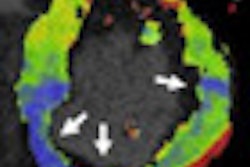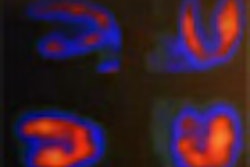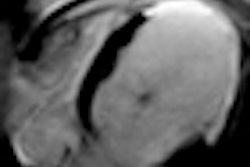Cardiovascular MRI is more accurate than SPECT for diagnosing coronary heart disease, according to the results of a prospective trial comparing the two from the University of Leeds in the U.K. Authors of the study, published online on 23 December in Lancet, say their results indicate that cardiac MRI should be adopted more widely.
SPECT imaging has increasingly been replacing exercise treadmill testing to assess myocardial ischemia, but this procedure exposes patients to a high radiation dose. What's more, the diagnostic accuracy of SPECT is of concern due to its variability.
A 1.3 million pound (1.6 million euro) study funded by the British Health Foundation evaluated the accuracy of cardiac MRI and SPECT in 752 patients who underwent cardiac MRI, SPECT, and coronary angiography exams. Patients suspected of having angina pectoris were recruited from Pinderfields General Hospital and Leeds Teaching Hospitals, enrolling in the clinical trial between March 2006 and August 2009. The exams were performed within a 30-day time frame, and patients were randomized with respect to which exam was performed first. The median time between cardiac MRI and SPECT imaging was seven days.
A total of 628 patients completed all three exams, reported lead author Dr. John Greenwood, a senior lecturer at the University of Leeds and a consultant cardiologist at Leeds NHS Teaching Hospitals Trust. Images were interpreted by masked, paired readers with at least 10 years of experience. If a decision was made to revascularize a patient following x-ray angiography, the SPECT exam results would be made available. However, the cardiac MRI results were always masked.
More than one-third of the patients (39%) had significant coronary heart disease identified by coronary angiography, the gold standard for the study. Only 11% of the patient cohort had had previous revascularization or acute coronary syndrome.
The sensitivity of cardiac MRI was 86.5%, compared with 66.5% for SPECT. Specificity did not differ significantly, at 83.4% for cardiac MRI and 82.6% for SPECT. The positive predictive values (PPV) for the two exams were similar, with cardiac MRI at 77.2% and SPECT at 71.4%. However, negative predictive values for these procedures different significantly, with cardiac MRI outperforming SPECT at 90.5% compared with 79.1%.
"We have shown convincingly that of the options available to doctors in diagnosing coronary heart disease, MRI is better than the more commonly used SPECT imaging test. As well as being more accurate, it has the advantage of not using any ionizing radiation, sparing patients and health professionals from unnecessary exposure," Greenwood said.
In an accompanying editorial, Dr. Robert Bonow of the Center for Cardiovascular Innovation of Northwestern University Feinberg School of Medicine in the U.S. wrote that the study, dubbed CE-MARC, was significant because of its more rigorous trial design, it recruited a larger patient population without bias than prior clinical trials, and it used a protocol that included multiple parameters, such as left ventricular function, stress perfusion, and myocardial viability.
"Because coronary angiography using [cardiac MRI] is neither universally available nor reasonable for all patients, it is noteworthy that the relative diagnostic accuracy of [cardiac MRI] was not diminished when the noninvasive coronary angiographic data were eliminated from the analysis," Bonow wrote.
However, he noted, advances in imaging must be coupled with enhanced patient well-being or a reduction in unnecessary downstream testing and procedures. He recommended that comparative effectiveness trials be performed to show whether cardiac MRI provides an incremental increase in value compared with SPECT and echocardiography in clinical practice.



















